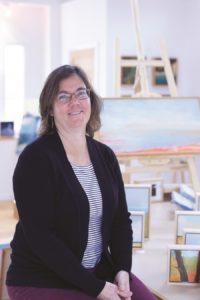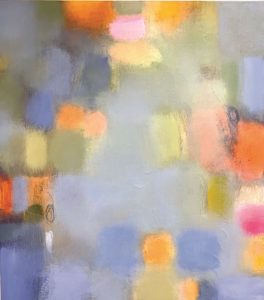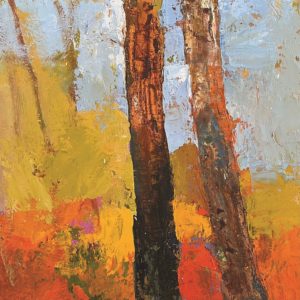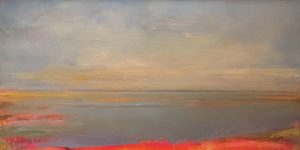“I have honed my visual sense,” says Heather Pilchard. “I notice patterns, changes in color. It’s all about observation. I’m always looking.”
Pilchard could just as easily be describing her artistic practice as her volunteer work for Mass Audubon in Wellfleet. She rescues cold-stunned sea turtles during the winter and tracks the nests of diamondback terrapins during the warmer months.

“I’m good at finding the nests,” says Pilchard. “You look for crawl marks or disturbances where the turtle buried her eggs.”
Pilchard is also skilled at finding the “nests” when it comes to landscape paintings that capture fleeting moments of light and color.
“Everything changes — the sand, the patterns of the sky,” she says. “That’s what inspires me: the magic of the Cape.” Her painting language — spontaneous and gestural, with fresh and fluid strokes — reflects this. The paint itself seems to be in a state of transition.

Pilchard moved to Wellfleet in 2006 and shortly thereafter began showing at the now-closed Harmon Gallery. She now lives in Eastham and shows at AMZehnder Gallery in Wellfleet. “Being on the Cape suits me,” she says. “There’s an artist spirit about it without the hustle and bustle of the city. It feels like home.”
Pilchard grew up mostly in the South, part of an artistic family. Her father, an art professor, moved the family to various college towns before settling at Appalachian State University in North Carolina. Once there, her mother stated, “I’m not moving anymore.”
“My parents were artists’ artists,” says Pilchard. “They were graphic designers by trade. They saw the world more visually. For vacations, we would always go to art museums.”

During one trip to the Southeastern Center for Contemporary Art, “My dad went out on this balcony and was staring out at the space,” Pilchard recalls. “He said, ‘Heather, look at the leaves. They all fall down differently.’ ” Pilchard says her father instilled “an almost spiritual sense of wonder and joy of observing.
“One thing about my family is that our expressions are very different,” continues Pilchard. “My dad’s work was bold and graphic; my mother’s work was lyrical and about color.” Two of Pilchard’s three brothers also became artists.
Though Pilchard enjoyed science in high school, she decided to pursue art. She left North Carolina to attend the School of the Museum of Fine Arts in Boston. “It was like being immersed in a creative womb,” Pilchard says. There she remembers hearing Wolf Kahn, one of her early influences.
“He does that balance between abstraction, landscape, and color,” she says. “These are the three elements I juggle.” In addition to Kahn, Pilchard lists Helen Frankenthaler and Hans Hofmann as inspirations. “In my heart, I’m an abstract painter,” she says.
Although she makes both abstract and representational work, even the representational work skews towards abstraction. “My art is less about detail and more about the essence of the landscape,” she says.

“My father had a heart attack, from which he recovered, right after I finished at the Museum School,” says Pilchard. “It was after that I started painting the landscape. It was a way to connect to him.”
Most of the works currently on display at AMZehnder feature a consistent motif: two expanses of color, one representing sky, the other land or water, separated by a sliver of land.
In Morning Marsh, Pilchard represents the spring-green salt marsh with brushy strokes that sit on the surface of the painting. These brushstrokes don’t describe space literally but rather create a bright expanse referencing color-field abstraction. Yet the color perfectly evokes the light and atmosphere of an overcast spring day on Cape Cod. In this way, the painting jostles the viewer between understanding the painting abstractly and representationally.
In Calm Ocean, Pilchard’s play with warm and cool colors calls to mind Hofmann’s “push-pull” theory. In this seascape, Pilchard interrupts the dominant cool blues of the water with a fluorescent orange ground to create a dynamic struggle.

“As soon as I get tight and obsessive, I lose the painting,” says Pilchard. “It seems so effortless, but it’s actually difficult to be that loose and gestural.”
Although constructed with urgency and speed, her paintings communicate a sense of peace and connection. It’s something she experiences on her daily walks and adventures as a “citizen scientist.”
“In nature you feel a part of the larger scheme of things,” she says. “That’s what I experience when I’m out there. It’s so old. These systems have been interconnected for millions of years. When you’re out there, you tap into that.”
